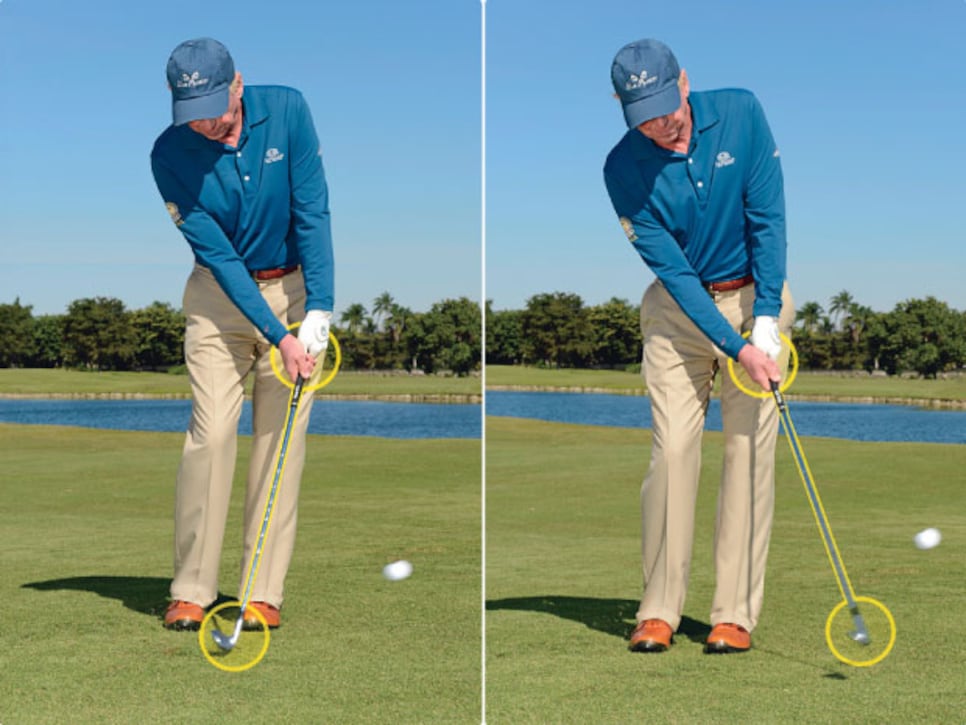To chip a golf ball and make it stop, use a lofted club and strike the ball with a descending blow. Aim for a soft landing with minimal roll.
Mastering the chip shot is essential for any golfer looking to lower their scores. Chipping involves a short, controlled swing aimed at getting the ball airborne and then stopping it quickly on the green. This technique is particularly useful around the greens where precision is crucial.
Using a lofted club like a sand wedge or lob wedge helps achieve the desired flight and spin. Focus on a clean, descending strike to impart backspin, which helps the ball stop rapidly after landing. Practicing this shot can significantly improve your short game, ultimately leading to better overall performance on the course.
Choosing The Right Club
Choosing the right club is crucial for chipping a golf ball effectively. The proper club can help you control the ball’s height, spin, and distance.
Wedges And Irons
When chipping, golfers typically use wedges or irons. Wedges offer higher loft, allowing the ball to fly higher and stop quickly. Common wedges include:
- Pitching Wedge (PW): Ideal for medium-height chips.
- Gap Wedge (GW): Useful for shots between a pitching and sand wedge.
- Sand Wedge (SW): Designed for bunkers but great for high, short chips.
- Lob Wedge (LW): Provides the highest loft, ideal for stopping the ball quickly.
Irons, such as the 7-iron or 8-iron, offer less loft. These are useful for lower, running chips. They help the ball roll more on the green.
Factors To Consider
Several factors influence the choice of club for chipping:
| Factor | Consideration |
|---|---|
| Distance | Shorter distances typically require wedges; longer distances may need irons. |
| Lie | If the ball is in rough grass, a wedge can help lift it out. |
| Green Conditions | On faster greens, a higher loft club helps stop the ball quickly. |
| Obstacle | Use a higher loft club to clear bunkers or tall grass. |
Understanding these factors can improve your chipping game. Practice with different clubs and see how each affects the ball’s behavior.
Perfecting Your Stance
Mastering your stance is crucial for a successful golf chip. A proper stance ensures accuracy and control, helping the ball stop near the hole. Follow these tips to perfect your stance and improve your chipping game.
Feet Position
Your feet should be close together. Stand with your feet about shoulder-width apart. This position helps maintain balance and control during the chip. Point your toes slightly outward. This allows for a more fluid motion.
Align your feet parallel to your target line. This alignment ensures the ball travels in the intended direction. Slightly bend your knees for better stability. A slight knee bend provides a solid foundation.
Weight Distribution
Distribute your weight evenly. Place more weight on your front foot. Around 60% of your weight should be on the lead foot. This weight distribution helps create a downward strike on the ball.
Keep your body centered over the ball. Avoid leaning too much to one side. This centered position aids in maintaining balance and control. Keep your hands ahead of the ball. This position encourages a clean, crisp contact.
Below is a simple table summarizing the key points:
| Aspect | Key Points |
|---|---|
| Feet Position |
|
| Weight Distribution |
|
By perfecting your stance, you’ll achieve better control and accuracy. This will help you chip the ball effectively and make it stop near the hole.
Grip Techniques
Mastering the grip is essential for chipping a golf ball. A good grip gives you control and precision. It helps make the ball stop where you want.
Proper Hand Placement
Proper hand placement is crucial. Start with your lead hand, which is the left hand for right-handed golfers.
Place the club in the fingers, not the palm. Ensure the thumb points down the shaft.
Next, place your trail hand, which is the right hand for right-handed golfers.
Overlap the pinky of your trail hand with the index finger of your lead hand. This creates a unified grip.
Grip Pressure
Grip pressure is vital for control. Hold the club lightly but firmly. Think of it as holding a bird.
A grip that is too tight can cause tension. Tension leads to poor shots.
Check your grip pressure often. Make sure it stays consistent throughout your swing.
| Aspect | Details |
|---|---|
| Lead Hand | Place in fingers, thumb down shaft |
| Trail Hand | Overlap pinky with lead hand index |
| Grip Pressure | Light but firm, like holding a bird |
- Proper hand placement gives control.
- Grip pressure ensures consistency.
Swing Mechanics
Understanding the swing mechanics is key to chipping a golf ball effectively. A good swing can make your ball stop exactly where you want it. Let’s delve into the fundamentals of the backswing and follow-through.
Backswing Tips
During the backswing, keep your hands soft and relaxed. This helps with control and precision.
- Use a slight wrist hinge.
- Keep your weight balanced.
- Focus on a smooth, controlled motion.
Maintain a steady tempo. Do not rush your backswing. This ensures better accuracy.
Follow-through
The follow-through is just as important as the backswing. Keep it controlled and smooth.
- Keep your head down until after impact.
- Finish with your chest facing the target.
- Maintain a relaxed grip throughout.
A proper follow-through helps the ball stop quickly. Practice this for consistent results.
| Key Points | Description |
|---|---|
| Backswing | Soft hands, balanced weight, smooth motion |
| Follow-Through | Head down, chest facing target, relaxed grip |
Ball Positioning
Mastering the art of chipping a golf ball involves understanding ball positioning. The way you position the ball affects its flight and stop. This section dives into the specifics of ball positioning, covering the distance from feet and its impact on trajectory.
Distance From Feet
Positioning the ball relative to your feet is crucial. Your stance should be narrow. A narrow stance provides better control. Place the ball slightly back in your stance. This helps in getting a clean hit. The ball should be closer to your right foot (for right-handed golfers).
| Distance from Feet | Effect on Chip |
|---|---|
| Too Close | May cause a thin shot |
| Too Far | May result in a fat shot |
| Just Right | Ensures clean contact |
Impact On Trajectory
The position of the ball impacts its trajectory. Placing the ball back in the stance makes it fly lower. This helps it stop quicker. For a higher shot, position the ball forward. This increases the trajectory, making it land softly.
- Low Trajectory: Back in stance, quick stop.
- High Trajectory: Forward in stance, soft landing.
Adjust the ball positioning based on the shot you need. Understanding these basics will improve your chipping game.

Credit: www.youtube.com
Controlling Ball Spin
Controlling the ball spin is essential in golf. It helps in making the ball stop quickly on the green. Mastering this skill will improve your short game significantly.
Creating Backspin
To create backspin, ensure clean contact with the ball. Use a wedge with a clean and dry clubface. Position the ball slightly back in your stance. Make a descending strike at the ball.
Generate backspin by accelerating through the shot. Keep your wrists firm. A steeper angle of attack helps too.
- Clean clubface
- Ball back in stance
- Firm wrists
- Accelerate through shot
Using Loft
The loft of your club plays a crucial role. Higher lofted clubs like a sand wedge or lob wedge create more spin. Choose the right club for the shot.
Open the clubface slightly to add more loft. This increases the spin and helps the ball stop quickly.
- Choose a high-lofted club
- Open the clubface
- Strike the ball cleanly
Using these techniques, you can control the spin effectively. Practice regularly to master the skill of making the ball stop on the green.
Reading The Green
Reading the green is crucial for a successful chip shot in golf. Understanding the terrain helps control the ball’s roll and stop it near the hole. This section focuses on two key factors: slope and breaks, and grass type.
Slope And Breaks
The slope and breaks of the green affect the ball’s movement. Observe the slope carefully. A downhill slope makes the ball roll faster. An uphill slope slows it down. Breaks are the curves on the green. These happen due to uneven terrain. Stand behind the ball and look towards the hole. This view helps see the breaks clearly. Use a practice stroke to gauge the impact of the slope and breaks.
| Type of Slope | Effect on Ball |
|---|---|
| Downhill | Faster roll |
| Uphill | Slower roll |
| Sidehill (Left to Right) | Ball breaks to the right |
| Sidehill (Right to Left) | Ball breaks to the left |
Grass Type
The type of grass also influences the ball’s movement. Bentgrass is smooth and fast. It makes the ball roll more. Bermuda grass is rougher. It slows the ball down. Check the grass type before chipping. Adjust your shot based on the grass. For fast greens, use a softer touch. For slow greens, chip with a bit more force.
- Bentgrass: Smooth, fast roll
- Bermuda grass: Rough, slow roll
Understanding the green’s features helps control your chip shots better. Practice reading the green often. It will improve your game significantly.

Credit: www.golfdigest.com
Practice Drills
Practicing your golf chip shots can significantly improve your short game. Focusing on practice drills ensures you build the right techniques and consistency. Below, we provide detailed drills to help you master chipping and make the ball stop effectively.
Short Game Drills
Short game drills are essential for refining your chipping skills.
- Target Practice: Place a few targets on the green. Try to chip the ball to land as close to each target as possible. This helps improve your accuracy and distance control.
- One-Handed Chips: Practice chipping with one hand at a time. Start with your dominant hand, then switch. This drill strengthens your control and ensures both hands work together smoothly.
- Bunker Chips: Chip from the bunker to the green. This helps you learn how to control the ball’s roll and spin. It’s a great way to build confidence in challenging situations.
Consistency Exercises
Consistency is key in making your chip shots reliable.
- Repetition Drill: Set up ten balls in a line. Chip each ball to a single target. Focus on using the same swing and technique for each shot. This builds muscle memory and ensures consistent performance.
- Pendulum Swing: Practice a smooth, pendulum-like swing. Use a metronome or count in your head. This keeps your rhythm steady and your chips more accurate.
- Distance Control: Place markers at different distances. Chip to each marker, adjusting your swing length. This helps you learn how far your chips travel with varying swings.
| Drill | Purpose |
|---|---|
| Target Practice | Improve accuracy and distance control |
| One-Handed Chips | Strengthen control and hand coordination |
| Bunker Chips | Control roll and spin from sand |
| Repetition Drill | Build muscle memory |
| Pendulum Swing | Maintain a steady rhythm |
| Distance Control | Learn chip distance with different swings |
Use these practice drills to refine your chipping skills. Regular practice will make your short game more reliable and effective. Enjoy the improvement in your golf performance.
Common Mistakes
Chipping a golf ball can be tricky. Many golfers make common mistakes. These mistakes can hurt your game. Let’s explore some errors and how to avoid them.
Overhitting
Overhitting is a frequent mistake. It happens when you use too much force. The ball travels too far and doesn’t stop.
Tips to avoid overhitting:
- Use a gentle swing.
- Practice your touch.
- Focus on accuracy, not distance.
Incorrect Club Choice
Using the wrong club can ruin your chip shot. Each club has a different purpose. Choosing the right one is crucial.
Tips for choosing the right club:
- Use a wedge for short, high shots.
- Use a 7 or 8 iron for longer chips.
- Experiment with different clubs during practice.
| Club Type | Best For |
|---|---|
| Wedge | Short, high shots |
| 7 or 8 Iron | Longer chips |
Advanced Tips
Chipping a golf ball and making it stop can be challenging. For advanced players, mastering this skill requires some advanced tips. Let’s dive into two key aspects: using bounce and adjusting for wind.
Using Bounce
Understanding the bounce on your wedge is crucial. Bounce refers to the angle between the leading edge and the lowest point of the club’s sole.
- High bounce: Use on soft or fluffy lies.
- Low bounce: Use on tight or firm lies.
Practice using different bounce angles. This helps you adapt to various course conditions. Experiment with your wedge to find the right bounce for each situation.
Adjusting For Wind
Wind plays a significant role in chipping. Adjusting your technique can make a huge difference.
- Against the wind: Use a lower lofted club. This helps keep the ball low.
- With the wind: Use a higher lofted club. This ensures the ball lands softer.
Always account for wind direction and speed. A slight adjustment in your stance or swing can help control the ball’s flight.
| Condition | Recommended Bounce | Recommended Loft |
|---|---|---|
| Soft Lies | High | Higher |
| Firm Lies | Low | Lower |
| Wind Against | Moderate | Lower |
| Wind With | Moderate | Higher |
By mastering these advanced tips, you can make your chips stop on a dime. Practice regularly and adjust based on conditions to improve your game.
Frequently Asked Questions
How To Chip A Golf Ball Consistently?
To chip a golf ball consistently, focus on a narrow stance. Keep weight on your front foot. Use a simple, controlled swing. Maintain a steady head position. Practice regularly to refine technique.
How Do I Stop My Ball From Topping When Chipping?
To stop topping the ball when chipping, keep your weight forward, and hands ahead of the clubhead. Maintain a steady head.
How To Stop Fluffing Chip Shots?
To stop fluffing chip shots, keep your weight on your front foot. Maintain a steady rhythm. Use a descending strike. Practice regularly to build confidence.
How Do I Stop Attacking My Golf Ball?
Relax your grip, maintain a smooth swing, and focus on a steady follow-through. Practice proper stance and alignment.
Conclusion
Mastering the chip shot will improve your golf game significantly. Practice regularly to perfect your technique. Use these tips to control the ball’s stopping distance. Consistency and patience are key. Soon, you’ll see noticeable improvements. Enjoy the process and watch your scores drop.
Happy golfing!





